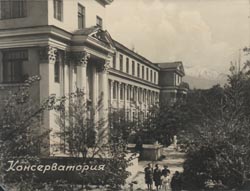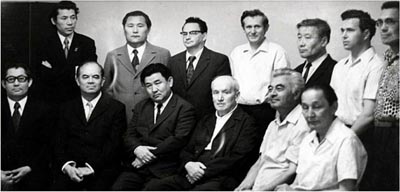History
For more than seven decades, Kurmangazy Kazakh National Conservatory has been training professional musicians. Compared to the conservatories of Europe and Russia, its age is insignificant, but in terms of eventfulness and dynamics of development, its history has concentrated a whole epoch. It reflected not only the formation of the first creative university, the formation of the entire system of professional music education, but also the history of the country - the Kazakh SSR, and then the sovereign Kazakhstan.

On April 30, 1944 the Council of People's Commissars of the USSR by its order obliged to organize a conservatory in Alma-Ata. In accordance with this order, on July 24, 1944, the Council of People's Commissars of the Kazakh SSR under the chairmanship of N. Undasynov decided on October 1 of the same year on the basis of the musical and choreographic combine (now the Almaty College of Music named after P. Tchaikovsky) to organize the State Institute of Arts, later transformed into the Alma-Ata Conservatory on the model of the Moscow and Leningrad conservatories. In 1945, the Conservatory was named after the outstanding Kazakh folk composer of the XIX century Kurmangazy Sagyrbayev.
During the years of the Great Patriotic War (1941-1945), outstanding figures of Russian art G. Ulanova, Y. Zavadsky, N. Sats, V. Maretskaya and many others were evacuated to Alma-Ata from Moscow. Their work in Kazakhstan significantly influenced the formation of the phenomenon of new Kazakh culture, which in a short period of time managed to assimilate and adapt the cultural traditions of Europe through the prism of Russian culture, which had been formed over centuries, without losing its national identity.
The leading role in this contradictory and complex process belonged to the Alma-Ata Conservatory. From the first days of its existence, its activity was conducted in two directions, determined by the impact of European and Kazakh national musical heritage. These two “branches” of the Conservatory always developed harmoniously and were equivalent.
Until recently, the Conservatory was the only higher educational institution in the country; it is rightly proud of its achievements. Almost all musical ensembles, concert organizations and educational institutions of the Republic are staffed with graduates of the Conservatory. Teachers and students of the Conservatory worthily represent the national art in the USA, Western and Eastern Europe, Russia, China, Turkey, Egypt, Qatar, Iran, Singapore, Thailand, Japan, South Korea and other countries.

There is a composer school presented by such glorified names as Ahmet Zhubanov, Evgeny Brusilovsky, Mukan Tulebayev, Sydyk Mukhamedzhanov, Kuddus Kuzhamyarov, Gaziza Zhubanova, Erkegali Rakhmadiyev.
Teaching staff of Conservatory is formed from the musicians who give large-scale concerts, whose works are recognized and demanded not only in Kazakhstan. Among them the outstanding pianist Zhaniya Aubakirova, the glorified chorus master Anatoly Molodov, the well-known baritone Ermek Serkebayev, the legendary singer Bibigul Tulegenova, "a golden trumpet" Yury Klushkin, a masterly dombrist Karshyga Akhmedyarov, the winner of the international competitions violinist Gauhar Murzabekova, a modern composer Erkegali Rakhmadiyev and many others.
Since Kazakhstan gained independence and sovereignty, the Conservatory was granted a status of "Kazakh National Institution of higher education." It became a starting point for objectives aimed at building a competitive Kazakhstani model of music education. In addition, the Conservatory entered the number of cultural and political priorities of the country.
Rectors of the Conservatory
Conservatory Today








